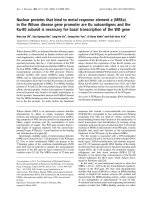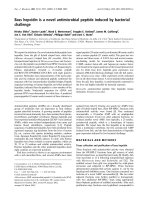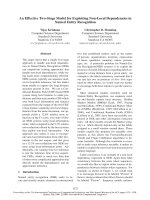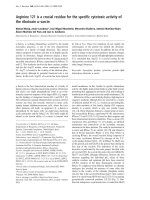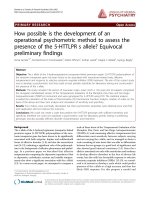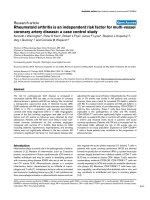Báo cáo y học: "Pro/Con debate: Is procalcitonin useful for guiding antibiotic decision making in critically ill patients" pdf
Bạn đang xem bản rút gọn của tài liệu. Xem và tải ngay bản đầy đủ của tài liệu tại đây (386.3 KB, 5 trang )
Page 1 of 5
(page number not for citation purposes)
Available online />Abstract
You are concerned about the escalating use of antibiotics in your
intensive care unit (ICU). This has put a strain on the ICU budget
and is possibly resulting in the emergence of resistant bacteria.
You review the situation with your team and one suggestion is to
consider using biomarkers such as procalcitonin to better guide
appropriate antibiotic decision making.
Pro: Time for goal-directed procalcitonin-
guided antibiotic therapy in the intensive care
unit
More than 40% of the patients in European and Australasian
intensive care units (ICUs) have sepsis or severe sepsis, but
only 58% of clinically suspected infections are confirmed by
positive culture [1]. While it is perfectly justifiable to
commence broad-spectrum antibiotics early, the decision to
continue or cease such therapy remains an arbitrary one by
the treating intensivist. This can lead to the indiscriminate
overuse of antimicrobials, with significant cost implications
and (of far greater concern) increasingly frequent outbreaks
of resistant organisms [2].
Procalcitonin is a SMART biomarker for sepsis and
infection
While fever, leukocytosis, and other responses to systemic
inflammation are clinical signs consistent with sepsis and
infection [3], they are neither specific nor sensitive to guide
antibiotic therapy at any stage during sepsis management. A
useful biomarker for sepsis must be Specific (as well as
Sensitive), Measurable with a high degree of precision,
readily Available (and Affordable), Responsive and
Reproducible, with results available in a Timely fashion to
guide therapy (SMART).
More specifically, a useful sepsis biomarker should do the
following [4]: (a) add value to the clinical evaluation, (b)
shorten the time to definitive diagnosis, and (c) differentiate
infectious and bacterial from noninfectious or nonbacterial
causes. The utility of a biomarker is enhanced if it reflects (i)
the severity of infection and the septic process and (ii) the
effectiveness of therapy, including antibiotics, earlier and
more accurately than clinical convention.
Procalcitonin (PCT) normally has a plasma level of less than
0.1 μg/L (ng/mL) in healthy subjects. Levels rise substantially
in response to triggers released during bacterial and systemic
infections, in particular endotoxin and inflammatory cytokines.
The elimination half-life of PCT is between 22 and 35 hours.
Whereas endotoxin and most other inflammatory cytokines
(tumor necrosis factor-alpha and interleukin [IL]-1) are
undetectable within 24 hours of an endotoxin challenge, PCT
starts to rise at 4 hours and peaks at between 8 and 24 hours
and C-reactive protein (CRP) rises slowly and peaks
36 hours after an endotoxin challenge [5].
PCT fulfills most of the criteria for a SMART biomarker. The
specificity and negative predictive value of PCT have been
substantially enhanced in newer assays by the improved
functional assay sensitivity of an amplified cryptate emission
technique [6,7]. The biostability of PCT makes it measurable
within a realistic clinical window with an assay that is
available and relatively affordable. PCT is responsive and
reflects the severity of the disease process and effectiveness
of therapeutic interventions [8]. With a half-life of about
24 hours, it allows for timely repeated measurements that
may reflect changes of the underlying clinical condition due
to therapy.
Review
Pro/Con debate: Is procalcitonin useful for guiding antibiotic
decision making in critically ill patients?
Yahya Shehabi
1
and Ian Seppelt
2
1
Acute Care Clinical Program, Intensive Care and Research, Prince of Wales Hospital, University of New South Wales, Barker Street, Randwick,
NSW 2031, Australia
2
Department of Intensive Care Medicine, Nepean Hospital, University of Sydney, Derby Street, Penrith, NSW 2751, Australia
Corresponding author: Yahya Shehabi,
Published: 2 May 2008 Critical Care 2008, 12:211 (doi:10.1186/cc6860)
This article is online at />© 2008 BioMed Central Ltd
COPD = chronic obstructive pulmonary disease; CRP = C-reactive protein; ICU = intensive care unit; IL = interleukin; PCT = procalcitonin; RCT =
randomised controlled trial; ROC AUC = area under the receiver operating curve; SMART = Specific (and Sensitive), Measurable, Available (and
Affordable), Responsive and Reproducible, and Timely.
Page 2 of 5
(page number not for citation purposes)
Critical Care Vol 12 No 3 Shehabi and Seppelt
PCT-guided management of antibiotics in the ICU requires
clinicians to change from their usual affirmative diagnostic
mindset to one in which negative confirmation is more
important (that is, that infection is extremely unlikely and
therefore antibiotics are inappropriate). The negative predic-
tive value of PCT for bacterial and systemic infection is
almost 99%. This should be the cornerstone of such a
strategy.
The clinical utility of a PCT assay was reported as early as
1993, when Assicot and colleagues [9] described high PCT
blood levels in patients with severe bacterial infections and
low levels in those without infection (6 to 53 versus less than
0.1 μg/L, respectively). They described a rapid decline in
PCT levels with antibiotic therapy and slightly elevated levels
(0.1 to 1.5 μg/L) in patients with noninvasive infections. It
was suggested more recently that a cutoff level of 0.5 μg/L
had a specificity of 96% in differentiating between bacterial
infections and other inflammatory processes [10]. At this
cutoff of 0.5 μg/L, the area under the receiver operating curve
(ROC AUC) discriminating bacterial from nonbacterial
infections was the highest at 0.84 for PCT when compared
with endotoxin, IL-6, and CRP (0.60, 0.77, and 0.78, respec-
tively) [11].
Recent trials have supported these earlier results, with strong
evidence in specific clinical areas, particularly respiratory
infections. Using a PCT-guided strategy, the ProRESP
(procalcitonin in lower respiratory tract infection) study in
Basel, Switzerland, reported a 50% reduction in antibiotic
usage in patients with lower respiratory tract infection [12]. A
similar study in suspected community-acquired pneumonia
(procalcitonin in patients with community-acquired pneu-
monia [ProCAP]), which used a PCT threshold of 0.25 μg/L
with a serial assay in 302 patients, led to a significant
reduction of both the duration of therapy and the overall
prescription of antibiotics in the PCT-guided arm compared
with conventional treatment guidelines (5.8 versus 12.9 days
and 85% versus 99%, respectively) [13]. Antibiotic
discontinuation rates were significantly higher in the PCT-
guided group. Stolz and colleagues [14] reported similar
results in a randomised trial (procalcitonin in chronic obstruc-
tive lung disease [ProCOLD]) that included 208 patients with
exacerbation of chronic obstructive pulmonary disease
(COPD) using a cutoff value of 0.1 μg/L measured on hospital
admission, with a 31.5% absolute reduction in antibiotic
exposure.
PCT has been shown to be the only independent variable
associated with the diagnosis of systemic infection, with up
to 99% specificity using a cutoff value of 0.5 μg/L [15].
These findings could not be replicated with a single PCT
assay in 243 febrile patients with a cutoff value of 0.2 μg/L
[16]. This emphasises the importance of serial PCT measure-
ments and integration of clinical findings into decision-making
processes.
Patients with severe pancreatitis who developed infective
necrosis or multiorgan dysfunction showed a sustained
increase in PCT levels. Unlike CRP, a striking discrimination
early in the course was observed with PCT. A relatively high
threshold of 3.5 μg/L gave a negative predictive value for
infective necrosis of 99% [17]. When the maximum recorded
PCT was used, the ROC AUC values were 0.86, 0.91, and
0.89 for infective necrosis associated with multiorgan
dysfunction, nonsurvival, or the combination of the two,
respectively [17].
In the postoperative cardiac surgery patients, a PCT value of
greater than 1.5 μg/L after the second postoperative day was
a much better predictor of infection than IL-6, IL-8, CRP, or
leukocytosis and was significantly higher in patients who died
[18].
The availability of a SMART biomarker like PCT, used as a
surrogate for bacterial infection, offers intensivists a golden
opportunity to rethink our approach to therapy in patients with
suspected infections in the ICU, and in particular the blind
and often inappropriate use of antibiotics. We must move
beyond the question of whether we should or should not use
PCT for antibiotic guidance and address the more critical
questions of integrating PCT into effective clinical decision
making and assess the full potential of its use in large-scale
clinical trials [19].
Müller and colleagues [19] have recommended a PCT-
guided diagnostic algorithm for patients with suspected
sepsis. This is based on data available to date which indicate
that a PCT of less than 0.1 μg/L rules out bacterial infection,
so antibiotics should not be used. Similarly, antibiotic use is
discouraged if the PCT is less than 0.25 μg/L. A rising PCT
should prompt a review of antibiotics or source control in
patients with systemic infections [19]. The algorithm
(Figure 1) is practical and simple.
The criterion ‘admission to ICU’ in Figure 1 refers to patients
who are not in the ICU. If those patients require admission to
the ICU, then reassessment and repeat PCT 6 to 24 hours
after admission may be indicated. For patients who are
already in the ICU, this criterion clearly does not apply.
Recently, a similar strategy was evaluated on a small number
of septic intensive care patients, with a significant reduction
in antibiotic usage [20].
While quality of care must be the primary objective driving
practice change, cost saving is a positive side effect. This
simple strategy can result in a reduction of up to 30% in
the cost of antibiotics. In an Australian general ICU (22
beds), this is equivalent to about US $80,000 per annum.
The impact of reduction in antibiotic usage on the
emergence of resistant organisms is a strategic gain that
needs to be addressed in adequately powered longitudinal
clinical trials.
Page 3 of 5
(page number not for citation purposes)
Con: PCT has not yet been validated for this
purpose in critical illness, so wait for the trials
It is increasingly clear that there is no ‘gold standard’
biomarker for sepsis. Four systematic reviews with meta-
analysis of PCT studies have been published in the last few
years [21-24]. While each looked at different patient groups
and included slightly different studies and some of the
methodology has been questioned, it is clear from each of
these analyses that, at best, PCT has only moderate positive
predictive value and is best used as one part of a
comprehensive clinical evaluation of the patient.
This scenario looks at the opposite use of the PCT assay, for
its negative predictive value, asserting that a patient with a
low PCT does NOT have bacterial sepsis. Although a recent
trial supports this notion in septic patients, numbers were
small with many exclusions [20]. However, there are good
data to support this assertion in other specific patient groups,
particularly patients with lower respiratory tract infections,
community-acquired pneumonia, or patients with exacer-
bations of COPD presenting to the emergency department,
where a PCT-guided treatment algorithm can significantly
reduce antibiotic use and duration of therapy without any
adverse effect on patient outcomes [12-14]. An observational
study during an outbreak of viral meningitis in children used
PCT to reduce unnecessary antibiotic use [25]. So while the
emergency department experience is positive, particularly for
respiratory infections, we are still waiting for a large trial that
evaluates PCT for this purpose in the critically ill, and until
such trials have been completed, we must be cautious.
Indeed, a number of randomised controlled trials (RCTs) are
currently under way in intensive care patients, and if we
accept that there is clinical equipoise for these studies, it is
crucial that we await their results! The Danish Procalcitonin
Study Group is conducting an RCT of a PCT-guided strategy
with mortality endpoints in critically ill patients (NCT00271752)
[26]. A French study is looking at another large group of
septic ICU patients (NCT00472667) [26]. A third study in
the US and Germany will be looking at the discontinuation of
antibiotics in ICU patients using a PCT-guided strategy
(NCT00407147) [26]. A fourth RCT in Switzerland is looking
specifically at PCT-guided strategies in ventilator-associated
pneumonia (ISRCTN61015974) [27].
In 2008, we can speculate that a PCT-guided antibiotic
strategy in the ICU might be efficacious but such a strategy
must be properly tested in a heterogenous group of critically
ill patients. So until these clinical trials have been completed,
we must keep an open mind about the generalisability of
findings from studies of specific disease processes. As well
as efficacy, we must consider safety. A strategy that recom-
mends withholding antibiotics but ends up harming patients
(by not giving the necessary antibiotics) is also of concern.
The PCT threshold for ‘suspected’ sepsis in critically ill
patients has not been adequately defined and varies signifi-
cantly from study to study. Different trials have used cutoff
values of 0.1, 0.25, 0.4, or 0.5 μg/L. It is becoming clear that
patients with a PCT between 0.25 and 0.5 μg/L may still have
sepsis (so a threshold of 0.5 μg/L is inappropriate), but
sufficient research has not yet been done to define precisely
where the threshold should be (0.25 or 0.1 μg/L or some
other number). Very different thresholds have been reported
in necrotising pancreatitis and after cardiac surgery [17,18],
which makes interpretation of this literature quite difficult and
Available online />Figure 1
Proposed algorithm for procalcitonin (PCT)-guided antibiotic therapy. ICU, intensive care unit. Reprinted with permission from Müller and
colleagues [19].
confusing. In a meta-analysis of diagnostic studies in critically
ill patients, a specific threshold effect could not be identified
[24], making the point that PCT is better used as a tool to
stratify risk in the clinical context than specifically as a binary
indicator. A large epidemiological study is required in
intensive care to specifically address the question of the most
appropriate PCT threshold(s) before the negative prediction
strategy in the scenario can be considered validated.
The threshold also depends on the type of assay used. Earlier
studies used a quantitative assay with a limited functional
assay sensitivity of 0.3 to 0.5 μg/L, whereas more recently an
assay with a functional sensitivity of 0.06 μg/L has been
available [28]. Clinical trials using a PCT-guided decision tool
must be interpreted in light of the functional sensitivity of the
assay used. All recent research has used the TRACE (time-
resolved amplified cryptate emission) technology assay
(Kryptor PCT; B·R·A·H·M·S Aktiengesellschaft, Henningsdorf,
Germany). It is crucial to know what assay is available to your
hospital before making any conclusions about the appro-
priateness of a ‘low PCT’ strategy to guide antibiotic therapy.
In addition to the quantitative assays, a semiquantitative
point-of-care test kit is available, and for reasons of cost and
speed, this is becoming popular (PCT-Q, a one-step immuno-
chromographic assay; B·R·A·H·M·S Aktiengesellschaft). After
30 minutes, this kit gives one of four responses: PCT <0.5,
0.5 to <2, 2 to 10, or >10 μg/L. The ‘<0.5 μg/L’ response of
this kit is used by clinicians to indicate that ‘bacterial sepsis is
unlikely’, but the threshold is probably too high for this
conclusion to be valid.
Finally, the time course and kinetics of PCT must be
considered. Falsely low levels will be seen if the PCT is
measured too early in the time course of an illness. Falsely
high levels may be seen after surgery, trauma, and burns but
will fall rapidly on serial testing [19].
It is clear that PCT is not a ‘magic marker’ for the positive
diagnosis of sepsis, nor has it yet been sufficiently validated
for the negative exclusion of sepsis in intensive care, although
it may well fit this role. As a matter of pragmatism, no
biomarker should ever be used in isolation for decision
making. It is one tool in the clinician’s armamentarium and
must be considered in conjunction with clinical examination,
other laboratory tests, and microbiological results. Algorithms
taking all of these factors into account are now being
evaluated [19]. In addition, newer laboratory techniques such
as multiplex polymerase chain reaction and microarray gene
mapping may become an essential part of the assessment of
sepsis in the future [29].
For PCT to be a useful assay to exclude infection and reduce
antibiotic use, results must be readily available to the clinician
for decision making, it must be sensitive and well validated at
low concentrations, and it must be cost-effective, taking into
account the equipment cost and day-to-day costs in the
laboratory. PCT has not yet been shown to fulfill this role in
critical illness.
Conclusion
While intensive care research that is more specific is needed
to validate this approach and a number of important trials are
currently under way, the scientific foundation for a PCT-
guided strategy to antibiotic therapy in intensive care is in
place. PCT has been tested in a number of the clinical condi-
tions (respiratory, abdominal, and postoperative infections)
that constitute the majority of infections treated in intensive
care. However, clinicians must be absolutely confident that
ALL patients who have an infection are appropriately treated
when using a PCT-guided negative prediction strategy.
In many ways, PCT can be considered analogous to better-
accepted biomarkers such as troponin T, which has a clear
threshold (0.1 μg/mL) and an excellent negative predictive
value for myocardial ischaemia, even though it can be
elevated in a number of other conditions such as sepsis and
renal failure, so elevated levels must be interpreted in the
context of the individual patient [30,31].
A number of prerequisites must be fulfilled before a PCT-
guided strategy can become ubiquitous in intensive care:
1. Intensivists must understand the limitations of PCT. It is
not a gold standard for the diagnosis of sepsis. It has no
value in the assessment of fungal or viral infections and
shows no response to intracellular microorganisms (such
as Mycoplasma) or in local infections with no systemic
response. Similarly, there are clinical conditions with a
high-baseline PCT like burns, major surgery, and systemic
inflammatory processes, which is why PCT is much more
useful for its negative predictive value.
2. The best PCT threshold still needs to be clearly defined in
critical illness, and it may be that there will be different
cutoff values recommended for negative prediction in
different clinical infections (for example, postcardiac
surgery, infective endocarditis, chest infections, and
paediatric infections). This makes the universal use of a
single negative predictive cutoff value more difficult,
although in general terms, the chance of significant sepsis
with a PCT of less than 0.1 μg/L is negligible, and
therefore a single negative predictive cutoff value can be
used in a simple predictive algorithm (Figure 1) [19].
3. The PCT assay must be a quantitative one with an
appropriate functional sensitivity to detect low levels of
PCT. The use of semiquantitative test kits is likely to be
problematic, with their high threshold (0.5 μg/L) increas-
ing the risk of false negatives. This may potentially mislead
clinicians.
4. Serial (daily) PCT levels should be used to monitor
progress over time. PCT can be used to assess the
adequacy of therapeutic interventions. If the level fails to
approximately halve each day or (especially) if levels start
Critical Care Vol 12 No 3 Shehabi and Seppelt
Page 4 of 5
(page number not for citation purposes)
to rise, the adequacy of treatment must be questioned,
leading perhaps to a change of antibiotics or surgical
intervention.
It is now time to validate a PCT-guided algorithm in large-
scale trials in critically ill patients, and the results of several
such trials are awaited. In the meantime, we support a simple
algorithm with cutoff values of less than 0.1 μg/L (no
antibiotics indicated) and less than 0.25 μg/L (discourage
antibiotics). This is appropriate and can be very useful for the
scenario given and is likely to produce a significant reduction
in antibiotic usage and a substantial reduction in costs,
without any evidence that patients will be put at risk.
Competing interests
The authors declare that they have no competing interests.
References
1. French C: The epidemiology of sepsis – is Australasia differ-
ent? Crit Care Resusc 2006, 8:219-222.
2. Thursky KA, Buising KL, Bak N, MacGregor L, Street AC, Macin-
tyre CR, Presneill JJ, Cade JF, Brown GV: Reduction of broad-
spectrum antibiotic use with computerized decision support
in an intensive care unit. Int J Qual Health Care 2006, 18:224-
231.
3. Abraham E, Matthay MA, Dinarello CA, Vincent JL, Cohen J, Opal
SM, Glauser M, Parsons P, Fisher CJ Jr., Repine JE: Consensus
conference definitions for sepsis, septic shock, acute lung
injury, and acute respiratory distress syndrome: time for a
reevaluation. Crit Care Med 2000, 28:232-235.
4. Reinhart K, Meisner M, Brunkhorst F: Markers for sepsis diagno-
sis: what is useful? Crit Care Clin 2006, 22:503-519.
5. Reinhart K, Karzai W, Meisner M: Procalcitonin as a marker of
the systemic inflammatory response to infection. Intens Care
Med 2000, 26:1193-1200.
6. Steinbach G, Rau B, Debard AL, Javourez JF, Bienvenu J, Ponzio
A, Bonfa A, Hubl W, Demant T, Kulpmann WR, Buchholz J, Schu-
mann G: Multicenter evaluation of a new immunoassay for
procalcitonin measurement on the Kryptor System. Clin Chem
Lab Med 2004, 42:440-449.
7. Morgenthaler NG, Struck J, Fischer-Schulz C, Seidel-Mueller E,
Beier W, Bergmann A: Detection of procalcitonin (PCT) in
healthy controls and patients with local infection by a sensi-
tive ILMA. Clin Lab 2002, 48:263-270.
8. Jensen J, Heslet L, Jensen T, Espersen K, Steffensen P, Tvede M:
Procalcitonin increase in early identification of critically ill
patients at high risk of mortality. Crit Care Med 2006, 34:
2596-2602.
9 Assicot M, Gendrel D, Carsin H, Raymond J, Guilbaud J, Bohuon
C: High serum procalcitonin concentrations in patients with
sepsis and infection. Lancet 1993, 341:515-518.
10. Delévaux I, Andre M, Colombier M, Albuisson E, Meylheuc F,
Bégue R-J, Piette J-C, Aumaître O: Can procalcitonin measure-
ment help in differentiating between bacterial infection and
other kinds of inflammatory processes? Ann Rheum Dis 2003,
62:337-340.
11. Aikawa N, Fujishima S, Endo S, Sekine I, Kogawa K, Yamamoto Y,
Kushimoto S, Yukioka H, Kato N, Totsuka K, Kikuchi K, Ikeda T,
Ikeda K, Harada K, Satomura S: Multicenter prospective study
of procalcitonin as an indicator of sepsis. J Infect Chemother
2005, 11:152-159.
12. Christ-Crain M, Jaccard-Stolz D, Bingisser R, Gencay MM, Huber
PR, Tamm M, Müller B: Effect of procalcitonin-guided treatment
on antibiotic use and outcome in lower respiratory tract infec-
tions: cluster-randomised, single-blinded intervention trial.
Lancet 2004, 363:600-607.
13. Christ-Crain M, Stolz D, Bingisser R, Müller C, Miedinger D,
Huber PR, Zimmerli W, Harbarth S, Tamm M, Müller B: Procalci-
tonin guidance of antibiotic therapy in community acquired
pneumonia: a randomised trial. Am J Respir Crit Care Med
2006, 174:
84-93.
14. Stolz D, Christ-Crain M, Bingisser R, Leuppi J, Miedinger D, Müller
C, Huber P, Müller B, Tamm M: Antibiotic treatment of exacer-
bations of COPD: a randomised, controlled trial comparing
procalcitonin-guidance with standard therapy. Chest 2007,
131:9-19.
15. Hausfater P, Garric S, Ben Ayed, S. Rosenheim M, Bernard M,
Riou B: Usefulness of Procalcitonin as a marker of systemic
infection in emergency department patients. Clin Infect Dis
2002, 34:895-901.
16. Hausfater P, Juillien G, Madonna-Py B, Haroche J, Bernard M,
Riou B: Serum procalcitonin measurement as diagnostic and
prognostic marker in febrile adult patients presenting to the
emergency department. Crit Care 2007, 11:R60.
17. Rau BM, Kemppainen EA, Gumbs AA, Büchler MW, Wegschei-
der K, Bassi C, Puolakkainen PA, Beger HG: Early assessment
of pancreatic infections and overall prognosis in severe acute
pancreatitis by Procalcitonin (PCT). Ann Surg 2007, 245:745-
754.
18. Jebali M, Hausfater P, Abbes Z, Aouni Z, Riou B, Ferjani M:
Assessment of the accuracy of procalcitonin to diagnose
postoperative infection after cardiac surgery. Anesthesiology
2007, 107:232-238.
19. Müller B, Schuetz P, Trampuz A: Circulating biomarkers as sur-
rogates for bloodstream infections. Int J Antimicrobial Agents
2007, 30S:S16-S23.
20. Nobre V, Harbarth S, Graf J-D, Rohner P, Pugin J: Use of procal-
citonin to shorten antibiotic treatment duration in septic
patients: a randomized trial. Am J Respir Crit Care Med 2008,
177:498-505.
21. Simon L, Gauvin F, Amre DK, Saint-Louis P, Lacroix J: Serum
procalcitonin and C-reactive protein levels as markers of bac-
terial infection: a systematic review and meta-analysis. Clin
Infect Dis 2004, 39:206-217.
22. Uzzan B, Cohen R, Nicholas P, Cucherat M, Perret GY: Procalci-
tonin as a diagnostic test for sepsis in critically ill adults and
after surgery or trauma: a systematic review and meta-analy-
sis. Crit Care Med 2006, 34:1996-2003.
23. Jones AE, Fiechtl JF, Brown MD, Ballew J, Kline JA: Procalcitonin
test in the diagnosis of bacteremia: a meta-analysis. Ann
Emerg Med 2007, 50:34-41.
24. Tang BM, Eslick GD, Craig JC, McLean AS: Accuracy of procal-
citonin for sepsis diagnosis in critically ill patients: systematic
review and meta-analysis. Lancet Infect Dis 2007, 7:210-217.
25. Marc E, Ménager C, Moulin F, Stos B, Chalumeau M, Guérin S,
Lebon P, Brunet F, Raymond J, Gendrel D: Procalcitonine et
méningites virales: réduction des traitements antibiotiques
inutiles par le dosage en routine au cours d’une épidémie
[Procalcitonin and viral meningitis: reduction of unnecessary
antibiotics by measurement during an outbreak]. Archives de
Pediatrie 2002, 9:358-364 [in French].
26. ClinicalTrials.gov homepage [].
27. Current Controlled Trials homepage
[].
28. Meisner M: Pathobiochemistry and clinical use of procalci-
tonin. Clin Chim Acta 2002, 323:17-29.
29. Tang BMP, McLean AS, Dawes IW, Huang SJ, Lin RCY: The use
of gene-expression profiling to identify candidate genes in
human sepsis. Am J Respir Crit Care Med 2007, 176:676-684.
30. Geppert A: Determination of troponin in the intensive care
patient: please avoid “troponinitis”. Crit Care Med 2005, 33:
1439-1441.
31. Amman P, Fehr T, Minder EI, Günter C, Bertel O: Elevation of
troponin I in sepsis and septic shock. Intens Care Med 2001,
27:965-969.
Available online />Page 5 of 5
(page number not for citation purposes)



